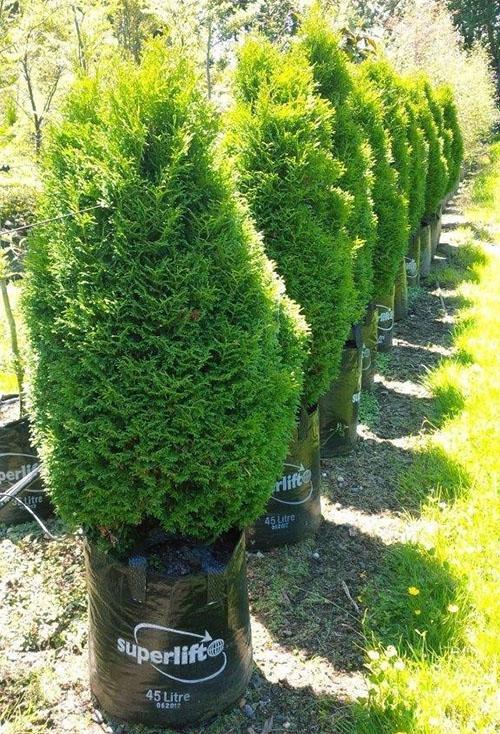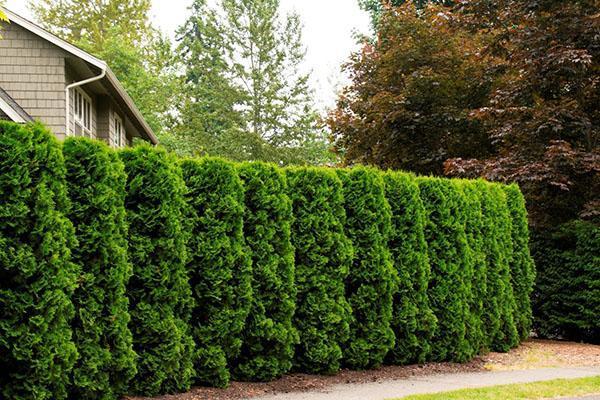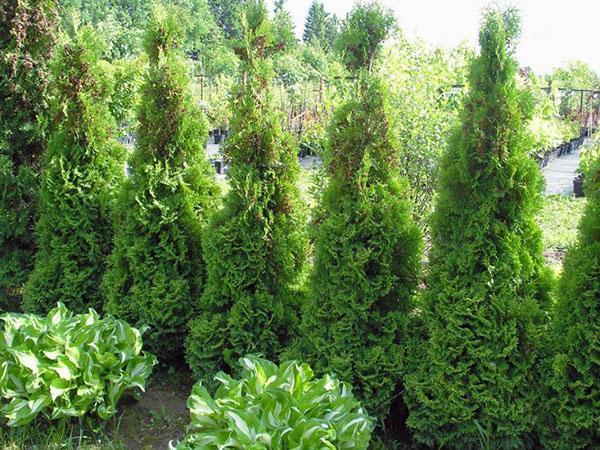The special role of thuja Holmstrum in the landscape design of a summer cottage
 Thuja with a dense conical crown are becoming more and more popular every year. Thuja Holmstrup is universal. It can become part of the greenery that preserves bright color. hedge, decorate the lawn near the house and be the backdrop for beautifully flowering plants.
Thuja with a dense conical crown are becoming more and more popular every year. Thuja Holmstrup is universal. It can become part of the greenery that preserves bright color. hedge, decorate the lawn near the house and be the backdrop for beautifully flowering plants.
Growing thuja, if we take into account the peculiarities of the culture, even a novice gardener can do. The plant has low growth rates, scaly needles resistant to external influences. Thuja does not need frequent pruning, it perfectly adapts to life in urban areas and on a personal plot.
Description and photo of thuya Holmstrup

- low growth rate;
- excellent winter hardiness;
- universal purpose.
According to the description, thuja Holmstrup, in the photo, protects the dark green color of scaly needles throughout the year. The plant is characterized by multiple branching of shoots, which makes the crown very dense and decorative.
Thuja is planted in the ground at different ages. The older the seedlings, the faster they reach the size of an adult bush. But landing large-sized trees is a task for professionals.
Usually, it takes at least 10 years to reach a height of one and a half or two meters. In this case, the diameter of the ephedra reaches 60 cm. With an annual vertical growth of up to 15 cm, the plant will take many more years for its dimensions to become limiting. In this case, the height reaches 3-4 meters, and the width of the dense crown is 80-120 cm.
 Ephedra is unpretentious. Thuja withstands without great losses:
Ephedra is unpretentious. Thuja withstands without great losses:
- frosts in the range of 29–34 ° C;
- growing near highways and industrial enterprises, where the air is saturated with chemicals, gases and other aggressive compounds;
- pruning, which helps to maintain the shape and decorativeness of the crown.
These features make it a valuable plant for landscape design... Having planted a shrub on the site, you can be sure that thuja Holmstrup will maintain its style for many years, and will not lose its attractiveness either in winter or in hot summer.
Thuja western Holmstrup: planting and care
 Tui prefer sunny, sheltered from the wind areas or light partial shade. Getting into shady corners, the coniferous culture can lose its characteristic appearance. The crown becomes sparse, stretched. The needles turn pale, react more sharply to changes in weather conditions and seasons, and are more often attacked by fungi and pests.
Tui prefer sunny, sheltered from the wind areas or light partial shade. Getting into shady corners, the coniferous culture can lose its characteristic appearance. The crown becomes sparse, stretched. The needles turn pale, react more sharply to changes in weather conditions and seasons, and are more often attacked by fungi and pests.
For comfortable growth, conifers need light, loose soil. Cultivated sandy loam or denser soils mixed with peat and sand are quite suitable. If a thuja Holmstrup seedling gets into an overly heavy substrate, its root system does not receive enough oxygen and nutrition. Dense soil retains a lot of water, which, when stagnant, causes rotting of the root system. In this case, you cannot do without a powerful drainage layer 15–20 cm thick, which is made at the bottom of the planting pit.
 These requirements must be taken into account when choosing a place for planting the selected coniferous crop.
These requirements must be taken into account when choosing a place for planting the selected coniferous crop.
The dimensions of the planting trench or pit depend on the size of the underground part of the seedling.If he has a closed root system, planting and caring for the thuja western Holmstrup is greatly simplified.
Most often, holes are dug for thuja with a depth of 60–80 cm and the same diameter. Backfill soil is made in advance by mixing:
- 1 part sand;
- 1 part low peat;
- 2 pieces of leafy land.
To stimulate growth, nitrogen-phosphorus fertilizers are mixed into the soil. Be sure to pay attention to the acidity level. The optimum pH for thuja and related species is 4.5–6 units.
A seedling grown in a container prior to planting should be watered abundantly, removed from the pot and placed on a layer of fresh substrate. The space between the walls of the pit and the earthen lump is filled with prepared soil so that the root collar is not covered with soil. The field of this soil is compacted, watered and mulch.
When planting plants with an open root system, it is important to gently spread the roots, spreading them along a previously poured cone from the soil.
 After planting, caring for thuja western Holmstrup includes:
After planting, caring for thuja western Holmstrup includes:
- regular watering, abundant enough to wet the root system;
- obligatory weeding under young shrubs;
- loosening the surface layer of the soil;
- spring feeding with the help of specialized mixtures that push the renewal and growth of needles;
- sanitary and formative pruning.
Although excess moisture is dangerous for thuja, lack of moisture causes oppression of the shrub. Therefore, in hot weather, young thujas are watered daily, for adult plants, the frequency of watering is increased, sprinkling and mulching with peat, sawdust, and mown grass are actively used. Before the beginning of winter, young thujas are tied and covered so that the snow does not damage the dense crown.
Tuya Holmstrup in landscape design
 Thuja of this variety is equally good in single and group plantings. The place of thuja Holmstrup in landscape design:
Thuja of this variety is equally good in single and group plantings. The place of thuja Holmstrup in landscape design:
- living evergreen walls along the edge of the site or along the border of functional zones;
- green islets on the lawn;
- background for decorative deciduous and flowering plants.
With regular haircut, thuja live well in bulky containers. And lovers of garden topiary art appreciate varieties as a good basis for original garden decoration.
Video acquaintance with thuja Holmstrup